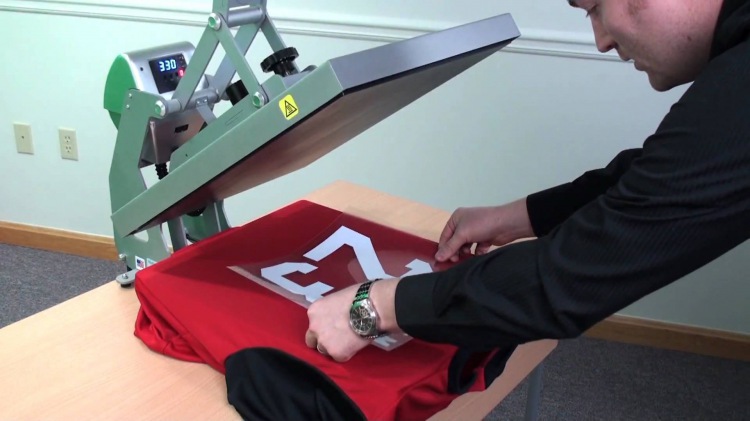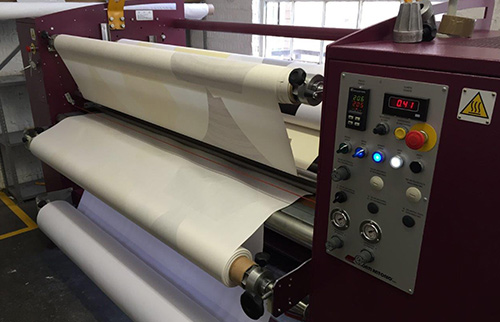
- 作者: Anne
- 来源:
- 日期: 2017-09-18
- 浏览次数: 3096次
One of the common processes in the T-shirt process is thermal transfer, so how much do you know about the thermal transfer process?

Thermal transfer printing refers to the printing process of transferring dye onto a fabric via transfer paper.
The thermal transfer printing is based on the sublimation characteristics of some disperse dyes, and the disperse dyes sublimed at 150 ° C ~ 230 ° C are selected, mixed with the slurry to make "color ink", and then according to different design patterns, "color ink" Printing onto the transfer paper, and then the transfer paper printed with the pattern is in close contact with the fabric, and under the control of a certain temperature, pressure and time, the dye is transferred from the printing paper to the fabric and diffused into the interior of the fabric. Thereby achieving the purpose of coloring.
The heat transfer printing has several methods such as sublimation method, swimming method, melting method and ink layer peeling method. Among them, the sublimation method is the most mature transfer printing.

1. Thermal transfer printing sublimation method
The thermal transfer printing sublimation method is the most commonly used method, using the sublimation property of the disperse dye, using a disperse dye having a molecular weight of 250 to 400, a particle diameter of 0.2 to 2 μm, and a water-soluble carrier (such as sodium alginate) or alcohol solubility. The carrier (such as ethyl cellulose) and the oil-soluble resin are used as an ink, and are treated on a transfer printing machine at 200 ° C to 230 ° C for 20 to 30 seconds to transfer the disperse dye to a synthetic fiber such as polyester and fix it.
The sublimation method generally goes through three processes: before the transfer process, all the dyes are in the printing film on the paper, the concentration of the dye in the printed fabric and the air gap is zero, and the size of the air gap depends on the structure of the fabric and the yarn count. And transfer pressure.
During the transfer process, when the paper reaches the transfer temperature, the dye begins to volatilize or sublimate, and a concentration volatilization occurs between the paper and the fiber. When the printed fabric reaches the transfer temperature, dye adsorption starts on the fiber surface until a certain saturation is reached. value.
Since the transfer of dye from paper to fiber is ongoing, the rate of adsorption depends on the rate at which the dye diffuses into the interior of the fiber. In order to allow the dye to diffuse directionally, a vacuum is often drawn on the underside of the dye to achieve a targeted diffusion transfer of the dye.
After the transfer process, after dyeing the dye, the dye content on the paper decreases, and some of the remaining dye migrates into the interior of the paper, and the amount of residual dye depends on
The vapor pressure of the dye, the affinity of the dye to the slurry or transfer paper, and the thickness of the printed film. The sublimation method generally does not require wet treatment, which saves energy and reduces the load of sewage treatment.
2, thermal transfer printing swimming method
The dye in the transfer paper ink layer is selected according to the nature of the fiber. The fabric is firstly padded by a mixture of fixing agent and paste, and then transferred by hot pressing in a wet state to transfer the dye from the transfer printing paper to the fabric and fixed, and finally steamed and washed. Wait for wet treatment. When the dye is transferred, a large pressure is required between the fabric and the transfer paper.
3. Thermal transfer printing melting method
The ink layer of the transfer paper is based on dyes and waxes. The ink layer is embedded in the fabric by melt and pressure, and part of the ink is transferred to the fibers, and then post-treated according to the properties of the dye. When the melting method is employed, a large pressure is required, and the transfer rate of the dye increases as the pressure increases.

Thermal transfer printing refers to the printing process of transferring dye onto a fabric via transfer paper.
The thermal transfer printing is based on the sublimation characteristics of some disperse dyes, and the disperse dyes sublimed at 150 ° C ~ 230 ° C are selected, mixed with the slurry to make "color ink", and then according to different design patterns, "color ink" Printing onto the transfer paper, and then the transfer paper printed with the pattern is in close contact with the fabric, and under the control of a certain temperature, pressure and time, the dye is transferred from the printing paper to the fabric and diffused into the interior of the fabric. Thereby achieving the purpose of coloring.
The heat transfer printing has several methods such as sublimation method, swimming method, melting method and ink layer peeling method. Among them, the sublimation method is the most mature transfer printing.

1. Thermal transfer printing sublimation method
The thermal transfer printing sublimation method is the most commonly used method, using the sublimation property of the disperse dye, using a disperse dye having a molecular weight of 250 to 400, a particle diameter of 0.2 to 2 μm, and a water-soluble carrier (such as sodium alginate) or alcohol solubility. The carrier (such as ethyl cellulose) and the oil-soluble resin are used as an ink, and are treated on a transfer printing machine at 200 ° C to 230 ° C for 20 to 30 seconds to transfer the disperse dye to a synthetic fiber such as polyester and fix it.
The sublimation method generally goes through three processes: before the transfer process, all the dyes are in the printing film on the paper, the concentration of the dye in the printed fabric and the air gap is zero, and the size of the air gap depends on the structure of the fabric and the yarn count. And transfer pressure.
During the transfer process, when the paper reaches the transfer temperature, the dye begins to volatilize or sublimate, and a concentration volatilization occurs between the paper and the fiber. When the printed fabric reaches the transfer temperature, dye adsorption starts on the fiber surface until a certain saturation is reached. value.
Since the transfer of dye from paper to fiber is ongoing, the rate of adsorption depends on the rate at which the dye diffuses into the interior of the fiber. In order to allow the dye to diffuse directionally, a vacuum is often drawn on the underside of the dye to achieve a targeted diffusion transfer of the dye.
After the transfer process, after dyeing the dye, the dye content on the paper decreases, and some of the remaining dye migrates into the interior of the paper, and the amount of residual dye depends on
The vapor pressure of the dye, the affinity of the dye to the slurry or transfer paper, and the thickness of the printed film. The sublimation method generally does not require wet treatment, which saves energy and reduces the load of sewage treatment.
2, thermal transfer printing swimming method
The dye in the transfer paper ink layer is selected according to the nature of the fiber. The fabric is firstly padded by a mixture of fixing agent and paste, and then transferred by hot pressing in a wet state to transfer the dye from the transfer printing paper to the fabric and fixed, and finally steamed and washed. Wait for wet treatment. When the dye is transferred, a large pressure is required between the fabric and the transfer paper.
3. Thermal transfer printing melting method
The ink layer of the transfer paper is based on dyes and waxes. The ink layer is embedded in the fabric by melt and pressure, and part of the ink is transferred to the fibers, and then post-treated according to the properties of the dye. When the melting method is employed, a large pressure is required, and the transfer rate of the dye increases as the pressure increases.